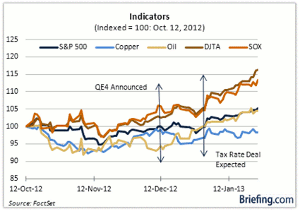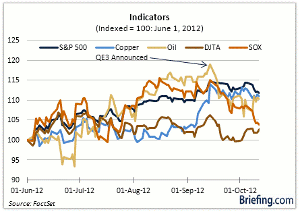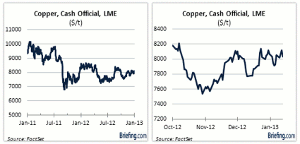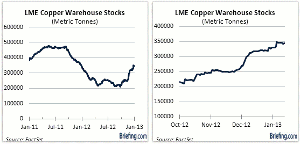The recent increase in global copper inventories and the inability of copper prices to break out when other leading market indicators are imbued with economic optimism is a curious thing, writes the staff at Briefing.com.
In our October 15, 2012, article, Trends That Can Make All the Difference, we called attention to the underperformance of some key market indicators following the announcement of QE3 in September. Specifically, we focused on copper, oil, the Dow Jones Transportation Average, and the Philadelphia Semiconductor Index.
We are taking another look at these indicators today, many of which are behaving in a way that seemingly portends good things for the economic outlook. By extension, that should mean good things for the earnings and stock market outlook as well.
These indicators, however, are not flashing a unanimous and indisputable sense of optimism about economic growth prospects.
There is a peculiar laggard in the mix; and it is the one indicator you might least expect given the market's optimism over the US housing recovery, the surge in auto sales, and the growth pickup in China.
That indicator is copper.
Time and Attention
At the time of our October post, we were not certain what the underpeformance of these four, leading indicators meant. We averred that it could simply be a case of profit taking after a big run leading up to the actual announcement of QE3 or that it could perhaps be a tacit signal that the market's confidence in the Federal Reserve to turn the economic and earnings tide in short order was waning.
The chart below shows the run-up to QE3 and the underperformance afterward into mid October.
Our concluding thought was that more time was needed to assess the performance of these leading market indicators and that the eventual path they followed—good or bad—could make all the difference for the market outlook.
We added that the manner in which the fiscal cliff debate played out would matter greatly in terms of dictating their direction.
Well, with the passage of time—and the passage of an income tax rate deal that averted the full impact of going over the fiscal cliff—these indicators have charted a new course that is drawing a lot of hopeful attention.
Paging Dr. Copper
Since our October post, the Dow Jones Transportation Average has surged 16% to an historic high; the Philadelphia Semiconductor Index is up 13%; and oil prices have jumped 5% to $96.06 per barrel.
It has been a different story for copper, however.
Copper prices are 2% lower today than they were in mid October.
To be fair, copper prices have perked up since mid November, yet the trajectory of the move belies the animal spirits that are stirring in other indicators.
This divergence bears close watching for the simple reason that copper is used extensively in industrial end markets and is euphemistically referred to as "Dr. Copper," because demand for the metal provides insight on the health of the economy.
NEXT PAGE: What Does It All Mean?
|pagebreak|
According to the Copper Development Association, electrical applications account for 65% of copper produced. Construction needs consume another 25% of copper production while transportation components take up another 7% of copper production.
The best we can tell in looking at copper prices now is that the global economy is out of intensive care. Its weak condition, though, is still serious despite the added liquidity injections from attending physician Dr. Bernanke and his dutiful residents around the world.
Market Prognosis: Recovery
The equity market for its part appears to be banking on a full, and fairly speedy, recovery for the global economy. That is evident in the outperformance of the cyclical sectors, the small-cap stocks, and the casual disregard for cautious earnings guidance for the first quarter. In turn, whether it is a search for yield or a hopeful economic line of thinking, junk bonds continue to rally.
Copper thus far isn't showing the same economic luster. Strikingly, copper inventories tracked by the London Metal Exchange have risen noticeably since mid October, which has helped keep prices in check.
Subdued copper prices, however, could be more of a supply-side issue than a demand issue. In other words, demand may be picking up but prices aren't spiking because of concerns about an overhang of excess supply in Chinese warehouses and an outlook for increased production in 2013.
The International Copper Study Group estimates that refined production of copper will increase 6.0% in 2013 to 21.2 million tonnes and that the increased output from new and existing mines could reverse a three-year trend of production deficits.
What It All Means
Looking at the moves in oil, the Dow Jones Transportation Average, and the Philadelphia Semiconductor Index since mid October, there is a basis to believe the economic outlook will get brighter. We suppose one could look at the move in copper prices off their mid-November lows to suggest the same.
However, the move in copper has simply gotten prices back to levels seen in mid-October when uncertainty about the US Presidential election was nearing its peak and worries about the fiscal cliff were escalating.
The election, of course, has been settled and the fiscal cliff has been downgraded to a fiscal slope. The stock market responded favorably in the wake of both developments, aided along the way by added monetary support from the Federal Reserve.
Copper prices actually rolled over shortly after the Fed announcement before regaining their footing at the end of last year.
Still, the recent build in copper inventories and the inability of copper prices to break out when other leading market indicators are imbued with economic optimism is a curious thing.
Those other indicators and the stock market, led by cyclical sectors, could continue to run in the first half, but we're respectful of the possibility that the lagging participation of copper could be the canary in the coal mine that points to economic disappointment in the months ahead.
The potential for disappointment is there, too. The payroll tax hike and fiscal austerity will bite in the US and currency debasement risks inviting protectionist policies around the globe.
Copper hasn't lost its luster, but as one of the foremost leading indicators, we're surprised it isn't shining brighter than it is.
By the Staff of Briefing.com























